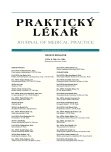Variants of human chromosomes and their significance from the point of view of clinical genetics
Authors:
A. Šípek jr. 1; R. Mihalová 1; A. Panczak 1; L. Celbová 1; A. Šípek 2,3,4; I. Hazdrová 2; V. Gregor 2,3,5
Authors‘ workplace:
Ústav biologie a lékařské genetiky 1. LF UK a VFN, Praha, Přednostka: doc. MUDr. Milada Kohoutová, CSc.
1; Oddělení lékařské genetiky, Thomayerova nemocnice, Praha, Primář: MUDr. Vladimír Gregor
2; Screeningové centrum Praha – Sanatorium PRONATAL, Odborný vedoucí: doc. MUDr. Tonko Mardešič, CSc.
3; Ústav obecné biologie a genetiky 3. LF UK, Praha, Přednostka: doc. MUDr. Marie Černá, CSc.
4; Katedra lékařské genetiky, Institut postgraduálního vzdělávání ve zdravotnictví, Praha, Vedoucí: prof. MUDr. Petr Goetz, CSc.
5
Published in:
Prakt. Lék. 2012; 92(4): 205-209
Category:
Of different specialties
Overview
The first association of a chromosomal anomaly (trisomy of chromosome 21) with a pathological phenotype (Down syndrome) was discovered more than 50 years ago. Since that time clinical genetics itself has changed a great deal. Today we know of many numerical and structural abnormalities of the human karyotype, which are causal for different clinical syndromes. However – not each of the chromosomal abnormalities is believed to be pathological. Today we know a number of so called heteromorphisms – variants of the human karyotype that do not affect the phenotype of their carriers. Nearly all of these variants are inherited from one of the parents. The chromosomes with the areas of constitutive heterochromatin (1, 9, 16 and Y) and acrocentric chromosomes (13, 14, 15, 21 and 22) are commonly involved. Although these findings are neither uncommon nor clinically significant, the interpretation of the findings by cytogeneticists and clinical geneticists can be sometimes difficult. Also – whenever there is a complete cytogenetic formula – including the variant – in the clinical report provided to the patient, it is necessary to inform the patient very clearly about the benign character of this finding in order to prevent unnecessary anxiousness.
Keywords:
karyotype, chromosomes, heteromorphism, heterochromatine.
Sources
1. Balíček, P. Paracentrické inverze lidských chromozómů a jejich rizika. Čas. lék. čes., 2004, 143(1), s. 35–38.
2. Balíček, P. Pericentrické inverze lidských chromozomů a jejich rizika. Čas. lék čes., 2001, 140(2), s. 38–42.
3. Bhasin, M.K. Human population cytogenetics: A review. Int J Hum Genet, 2005, 5(2), p. 83–152.
4. Brothman, A.R., Schnedier, N.R., Saikevych, I., et al. Cytogenetic heteromorphisms: survey results and reporting practices of giemsa-band regions that we have pondered for years. Arch Pathol Lab Med, 2006, 130(7), p. 947–949.
5. E.C.A. Permanent Working Group for Cytogenetics and Society, Cytogenetic Guidelines and Quality Assurance: A common European framework for quality assessment for constitutional and acquired cytogenetic investigations, 2007, 33 p. Dostupné z: http://www.biologia.uniba.it/eca/ NEWSLETTER/NS-17/Guidelines.pdf.
6. Gardner, R.J. McK., Sutherland, G.R. Chromosome abnormalities and genetic counseling. 3rd ed. Oxford: Oxford University Press, 2004, 577 p.
7. Hong, Y., Zhou, Y.W., Tao, J., et al. Do polymorphic variants of chromosomes affect the outcome of in vitro fertilization and embryo transfer treatment? Hum Reprod, 2011, 26(4), p. 933–940.
8. Kowalczyk, M., Srebniak, M., Tomaszewska, A. Chromosome abnormalities without phenotypic consequences. J Appl Genet, 2007, 48(2), p. 157–166.
9. Lejeune, J., Gautier, M., Turpin, R. Etude des chromosomes somatiques de neuf enfants mongoliens. C R Hebd Seances Acad Sci, 1959, 248(11), p. 1721–1722.
10. Lejeune, J., Lafourcade, J., Berger, R., et al. Trois cas de délétion partielle du bras court d’un chromosome 5. C R Hebd Seances Acad Sci, 1963, 257(18), p. 3098–3102.
11. Shaffer, L.G., Slovak, M.L., Campbell, L.J. ISCN 2009: An international system for human cytogenetic nomenclature (2009). Basel: Karger, 2009, 138 p.
12. Starke, H., Mrasek, K., Liehr, T. Three cases with enlarged acrocentric p-arms and two cases with cryptic partial trisomies. J Histochem Cytochem, 2005, 53(3), p. 359–360.
13. Starke, H., Seidel, J., Henn, W., et al. Homologous sequences at human chromosome 9 bands p12 and q13-21.1 are involved in different patterns of pericentric rearrangements. Eur J Hum Genet, 2002, 10(12), p. 790–800.
14. Tjio, J.H., Levan, A. The chromosome number of man. Hereditas, 1956, 42, p. 1–6.
15. Verma, R.S., Dosik, H. Human chromosomal heteromorphisms: nature and clinical significance. Int Rev Cytol, 1980, 62, p. 361–333.
16. Wyandt, H.E., Tonk, V.S., et al. Atlas of human chromosome heteromorphisms. Dordrecht: Kluwer Academic Press, 2004, 3000 p.
Labels
General practitioner for children and adolescents General practitioner for adultsArticle was published in
General Practitioner

2012 Issue 4
Most read in this issue
- Asthma and nutrition: diet for the primary prevention and treatment of asthma
- Variants of human chromosomes and their significance from the point of view of clinical genetics
- What is the risk of disease caused by Legionella in the Czech Republic?
- The importance of histological verification of tumour metastasis
